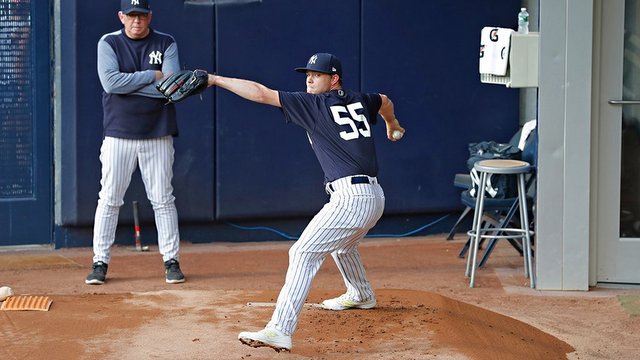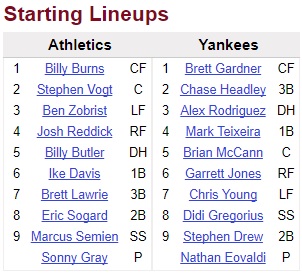
Later tonight right-hander Sonny Gray will make his first start with the Yankees after coming over from the Athletics prior to Monday’s trade deadline. He’ll face the same Indians team he held scoreless over six innings just three weeks ago. I’m sure Gray will feel some “first start with his new team” butterflies and all that, but one start is just one start. As long there are (many) more good starts than bad starts, the Yankees will be happy.
Gray is making the move from Oakland Coliseum to Yankee Stadium, which is going from one extreme on the ballpark spectrum to the other. Oakland Coliseum is pitcher friendly thanks to the spacious outfield, the tall outfield walls, and all that foul territory. Yankee Stadium is pretty much the exact opposite. Short porch, not much foul territory, so on and so forth. Gray’s moving from a big time pitcher’s park to a big time hitter’s park.
So far Gray has made just one career start at Yankee Stadium, back in 2015 when the held the Yankees to three runs in seven innings. If you’re using that to forecast how Gray will perform going forward, stop. It’s meaningless. It’s one start. One start against a lineup …
… Gray will never face again. That one start tells us nothing useful. There’s not a pitcher alive who wouldn’t see their numbers get worse moving from Oakland Coliseum to Yankee Stadium. They are very different ballparks and very different run-scoring environments. You have to adjust your expectations accordingly knowing how hitter friendly Yankee Stadium can be.
Now, that all said, there are reasons to believe Gray is built to succeed in Yankee Stadium. First and foremost, Gray is a ground ball pitcher, and the next ground ball I see hit over the short porch will be the first. Among the 99 pitchers who have thrown at least 90 innings this year, Grays ranks seventh with a 56.7% ground ball rate. Since the start of the 2014 season, he’s fifth with a 54.6% ground ball rate. Ground balls are good.
Get that many ground balls over that long a period of time and it’s not a fluke. What makes Gray’s consistently above-average ground ball rate impressive is that he doesn’t do it with one pitch. Many great ground ball pitchers have that heavy sinker they use to pound the bottom of the zone. Gray gets ground balls with multiple pitches. Here are his 2017 numbers:
- Four-Seam Fastball: 63.3% grounders (37.8% league average)
- Two-Seam Fastball: 62.1% grounders (51.5% league average)
- Slider: 51.4% grounders (44.8% league average)
- Changeup: 45.5% grounders (49.5% league average)
- Curveball: 32.1% grounders (47.7% league average)
The two fastballs and the slider have been comfortably above-average ground ball pitches. The changeup, his least used offering (6.5% in 2017), is a tick below-average. The curveball has been well-below-average at getting ground balls this season, though that’s an outlier. Gray’s curveball had a 46.5% ground ball rate last year. It was 52.3% the year before that and 53.5% the year before that.
Even if Gray’s curveball is permanently broken as a ground ball pitch — batters have put his curveball in play only 25 times this season, so I’m betting it’s sample size noise — he still takes three above-average ground ball pitches to the mound on any given day, plus a fourth that is average-ish. He’s not someone who, when he needs a ground ball, has to throw his two-seamer. Or has to throw his slider. He has more than one option.
Secondly, Gray is really good against left-handed batters. A righty who can’t keep lefties in check is going to have a really hard time in the Bronx. His numbers against lefties:
| BF | AVG/OBP/SLG | wOBA | K% | BB% | GB% | HR/9 | Hard% | |
|---|---|---|---|---|---|---|---|---|
| 2014 | 489 | .219/.300/.339 | .289 | 20.7% | 9.6% | 58.0% | 0.76 | 25.2% |
| 2015 | 425 | .208/.275/.303 | .260 | 21.9% | 8.0% | 56.3% | 0.68 | 26.7% |
| 2016 | 256 | .280/.329/.427 | .325 | 19.1% | 6.3% | 51.6% | 0.91 | 28.6% |
| 2017 | 191 | .220/.277/.335 | .269 | 23.0% | 7.3% | 57.4% | 0.58 | 26.3% |
Gray was injured and bad all around last season, against both righties and lefties. When healthy from 2014-15 and in 2017, he’s been very good against left-handed batters, especially at keeping the ball on the ground and limiting hard contact. (The MLB average is a 32.1% hard contact rate.) Preventing lefties from getting the ball airborne is imperative in Yankee Stadium.
As you’d expect, Gray uses his slider more against righties and his changeup more against lefties, otherwise his fastball and curveball usage is the same against all hitters. That curveball is the difference-maker. It’s a high-quality pitch Gray can throw for strikes or bury in the dirt for swings and misses, and he throws it at any time. Many starters are fastball-breaking ball against same-side hitters and fastball-changeup against guys on the other side of the plate. Gray is fastball-cuveball-slider against righties and fastball-curveball-changeup against lefties.
Another reason Gray won’t suffer too much from the move from the Oakland Coliseum to Yankee Stadium? He doesn’t rely on pop-ups. There’s sooo much foul territory in Oakland. Balls that land behind the dugouts in many ballparks are caught for outs at the Coliseum. Those cheap outs have allowed dudes like Tommy Milone and Jesse Chavez to function as viable starters for the A’s, but nowhere else. Here is Gray’s pop-up spray chart overlaid on Yankee Stadium, via Baseball Savant:
That covers 2014-17, so that’s 641 innings worth of pop-ups there. You can count on one hand the number that were outs at Oakland Coliseum but would have been in the seats elsewhere. Will Gray lose some easy foul pop-up outs given the smaller foul territory at Yankee Stadium? Of course. But he wasn’t relying on them for success anyway. He’s a ground ball/strikeout guy. Not a pop-up guy.
One last thing to keep in mind — and this is not ballpark specific — is the Yankees are a substantially better defensive team than the Athletics. Remember how much the A’s kicked the ball around during the two series with the Yankees? The A’s might be the worst defensive team in baseball this season.
A’s DRS: -50 (30th among all MLB teams)
A’s UZR: -42.0 (30th)
A’s Defensive Efficiency: 0.706 (14th)
Yankees DRS: -5 (16th)
Yankees UZR: +4.9 (11th)
Yankees Defensive Efficiency: 0.711 (6th)
Gray’s ability to get ground balls with multiple pitches and use those pitches to neutralize left-handed batters are why it appears he is well-suited for Yankee Stadium despite being a short (5-foot-10) right-handed pitcher. He’s very unique in that regard. Not many pitchers that size can get ground balls. That the Yankees are a far superior defensive team to the A’s is icing on the cake. More of those grounders will be turned into outs.
As far as pitching well in New York and the AL East, I’m not concerned about Gray at all. He has a lot of weapons and he’s extremely competitive. The only concern I have with Gray is his health. As long as his arm stays in one piece, I think he’s going to be very effective for the Yankees, and I don’t think it’ll take long for him to become a fan favorite. Moving from Oakland Coliseum to Yankee Stadium will hurt his performance because it would hurt anyone’s performance. Gray has the tools to minimize the ballpark related damage, however.


Leave a Reply
You must be logged in to post a comment.